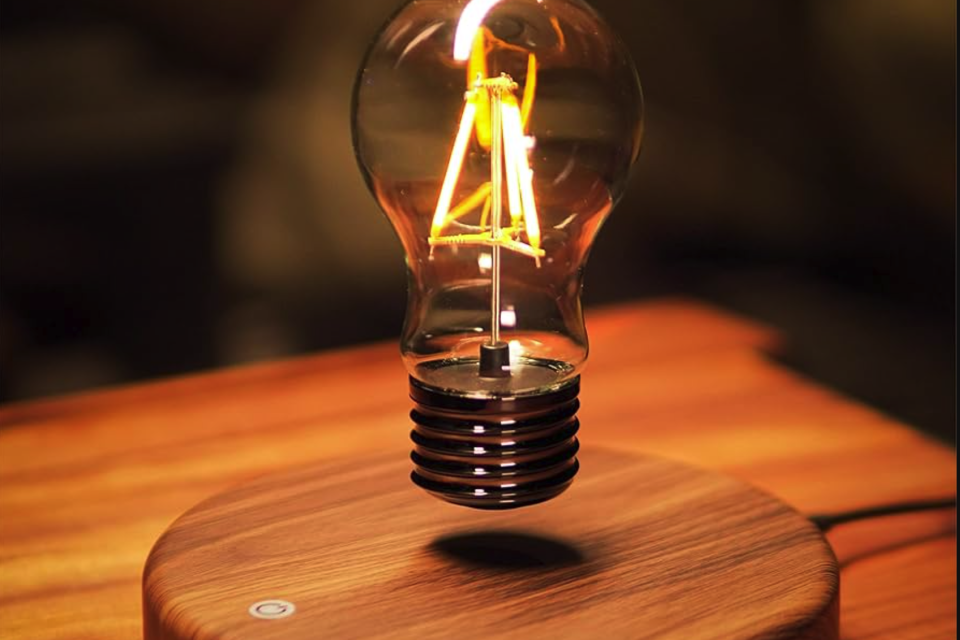Levitating magnetic light is a fascinating intersection of physics and engineering, primarily rooted in the principles of magnetism and electromagnetic fields. At its core, this technology utilizes magnetic levitation, a phenomenon where an object is suspended in the air without any physical support. This is achieved through the use of powerful magnets that create a magnetic field strong enough to counteract the force of gravity.
The most common method employed in levitating light systems is known as magnetic suspension, which involves the use of superconductors or permanent magnets arranged in a specific configuration to achieve stable levitation. The science behind this technology can be traced back to the work of physicists like Michael Faraday and James Clerk Maxwell, who laid the groundwork for understanding electromagnetic fields. In practical applications, levitating magnetic light Enconco often employs a combination of permanent magnets and electromagnets.
The interaction between these two types of magnets allows for precise control over the position and stability of the levitating object. For instance, when an electromagnet is activated, it can create a dynamic magnetic field that adjusts in real-time to maintain the levitation of the light source, ensuring it remains suspended even when external forces are applied.
Benefits of Levitating Magnetic Light
One of the most significant benefits of levitating magnetic light is its unique aesthetic appeal. The visual impact of a light source floating in mid-air can transform any space, adding a futuristic and artistic element to interior design. This captivating feature not only serves as a conversation starter but also enhances the overall ambiance of a room.
The ability to create a visually striking centerpiece can elevate the design of homes, offices, and public spaces alike. In addition to its aesthetic advantages, levitating magnetic light offers practical benefits as well. For instance, because these lights are suspended and do not require traditional mounting methods, they can be placed in unconventional locations without the need for fixtures or supports.
This flexibility allows for innovative lighting solutions that can adapt to various environments. Furthermore, many levitating light systems incorporate energy-efficient LED technology, which not only reduces energy consumption but also extends the lifespan of the lighting solution. This combination of style and efficiency makes levitating magnetic light an attractive option for modern consumers.
Applications of Levitating Magnetic Light
The applications of levitating magnetic light are diverse and span various industries. In residential settings, these lights can serve as statement pieces in living rooms or dining areas, providing both illumination and artistic flair. Their ability to float allows for creative arrangements that can enhance the overall design aesthetic of a home.
Additionally, they can be used in bedrooms as ambient lighting, creating a serene atmosphere that promotes relaxation. Commercially, levitating magnetic lights have found their way into retail environments, where they can be used to highlight products or create immersive shopping experiences. For example, high-end boutiques may utilize these lights to draw attention to specific displays or merchandise, enhancing the overall shopping experience for customers.
In corporate settings, they can be employed in conference rooms or lobbies to convey innovation and forward-thinking values, aligning with a company’s brand identity. Moreover, educational institutions and museums are beginning to adopt levitating magnetic light as part of their exhibits. By incorporating this technology into displays, they can create engaging environments that captivate visitors’ attention while also providing functional lighting.
The versatility of levitating magnetic light makes it suitable for various applications, from residential to commercial and educational settings.
How Levitating Magnetic Light Works
The operation of levitating magnetic light hinges on the principles of magnetism and electromagnetic induction. At its core, the system consists of a light source—typically an LED bulb—mounted on a base equipped with magnets. The base contains both permanent magnets and electromagnets that work together to create a stable magnetic field capable of suspending the light source in mid-air.
When powered on, the electromagnets generate a magnetic field that interacts with the permanent magnets in such a way that it creates lift. This lift counteracts gravitational forces, allowing the light source to float freely. The system is designed with feedback mechanisms that continuously monitor the position of the light source.
If it begins to drift or tilt due to external disturbances—such as air currents or vibrations—the system adjusts the strength of the electromagnets accordingly to maintain stability. This dynamic adjustment is crucial for ensuring that the levitating light remains suspended without wobbling or falling. Advanced sensors detect changes in position and send signals to the control system, which modulates the electromagnetic field in real-time.
This intricate interplay between sensors, control systems, and magnetic fields exemplifies how modern technology can harness fundamental scientific principles to create innovative solutions.
The Future of Lighting Technology
As we look toward the future of lighting technology, levitating magnetic light represents just one facet of an evolving landscape characterized by innovation and sustainability. With advancements in materials science and engineering, we can expect to see even more efficient and versatile lighting solutions emerge. The integration of smart technology into lighting systems is already underway, allowing for greater control over illumination levels and energy consumption through mobile applications and voice-activated devices.
Moreover, as urbanization continues to rise globally, there is an increasing demand for sustainable lighting solutions that minimize energy usage while maximizing aesthetic appeal. Levitating magnetic lights align with this trend by offering energy-efficient options that reduce reliance on traditional power sources. As renewable energy technologies advance, we may see levitating lights powered by solar energy or other sustainable methods, further enhancing their environmental credentials.
Additionally, research into new materials—such as advanced superconductors—could lead to even more efficient levitation systems that require less energy to operate. This could open up new possibilities for applications in various fields, including transportation and architecture. As lighting technology continues to evolve, levitating magnetic light stands at the forefront of innovation, poised to redefine how we illuminate our spaces.
Comparing Levitating Magnetic Light to Traditional Lighting
When comparing levitating magnetic light to traditional lighting solutions, several key differences emerge that highlight the advantages and disadvantages of each approach. Traditional lighting systems typically rely on fixed fixtures that require installation and often limit placement options within a space. In contrast, levitating magnetic lights offer unparalleled flexibility in positioning since they do not require physical supports or mounting hardware.
This freedom allows for creative arrangements that can adapt to changing design needs. Another significant difference lies in energy efficiency. Many traditional lighting options—especially incandescent bulbs—consume considerable amounts of energy and have shorter lifespans compared to modern LED technologies used in levitating lights.
LEDs are known for their longevity and low energy consumption, making them an environmentally friendly choice. Furthermore, when combined with magnetic levitation technology, these lights can operate with minimal energy loss due to their efficient design. However, traditional lighting systems often come with lower upfront costs compared to their levitating counterparts.
The complexity of manufacturing and engineering required for levitating lights can result in higher prices, which may deter some consumers from making the switch. Additionally, while traditional lighting has been around for decades and is widely understood by consumers, levitating magnetic lights are still relatively novel and may require education on their functionality and benefits.
Environmental Impact of Levitating Magnetic Light
The environmental impact of levitating magnetic light is an important consideration as society increasingly prioritizes sustainability in all aspects of life. One of the primary advantages of this technology is its potential for energy efficiency. By utilizing LED bulbs—known for their low power consumption—levitating lights can significantly reduce electricity usage compared to traditional incandescent or fluorescent options.
This reduction in energy consumption translates into lower greenhouse gas emissions associated with electricity generation. Moreover, the longevity of LED bulbs means that they need to be replaced less frequently than traditional bulbs, resulting in less waste over time. The materials used in manufacturing levitating lights can also be selected with sustainability in mind; for instance, manufacturers may choose recyclable materials or those sourced from sustainable practices.
This focus on eco-friendly materials contributes further to reducing the overall environmental footprint associated with lighting solutions. However, it is essential to consider the entire lifecycle of levitating magnetic lights when assessing their environmental impact. The production process for advanced technologies often involves resource-intensive manufacturing methods that may offset some of their ecological benefits.
Additionally, while these lights are designed for longevity, if they do reach end-of-life stages where disposal becomes necessary, proper recycling programs must be in place to mitigate waste.
Challenges and Limitations of Levitating Magnetic Light Technology
Despite its many advantages, levitating magnetic light technology faces several challenges and limitations that must be addressed for broader adoption. One significant hurdle is the cost associated with manufacturing these systems. The complexity involved in creating stable levitation mechanisms using advanced materials and precise engineering often results in higher prices compared to traditional lighting options.
This cost barrier may limit accessibility for some consumers and businesses. Another challenge lies in the technical requirements for installation and operation. While traditional lighting systems are generally straightforward to install and use, levitating lights may require specialized knowledge or equipment for setup and maintenance.
Users must also be educated about how to operate these systems effectively; otherwise, they may experience frustration if they encounter issues related to stability or power supply. Furthermore, environmental factors such as air currents or vibrations can impact the performance of levitating lights. While advanced sensors help mitigate these issues by adjusting electromagnetic fields dynamically, there may still be limitations in certain environments where stability cannot be guaranteed consistently.
As such, careful consideration must be given when selecting locations for installation. In summary, while levitating magnetic light technology presents exciting possibilities for innovative lighting solutions, it also faces challenges related to cost, installation complexity, and environmental sensitivity that must be navigated as it continues to develop within the broader context of modern lighting design.

